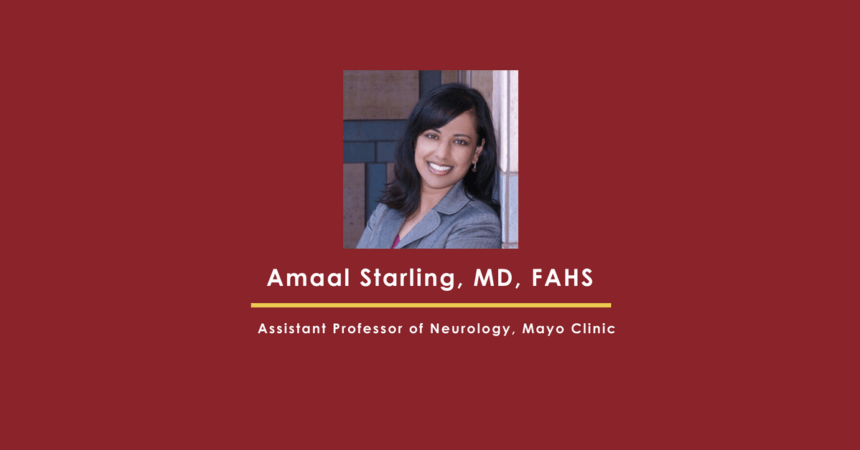
In Their Words: AHS Member Amaal Starling, MD, Shares Her Personal History with Migraine
Amaal Starling, MD, explains how she manages her migraine attacks and explains what physicians outside of the field should know about people living with migraine.
Amaal Starling, MD, a neurologist based at the Mayo Clinic in Scottsdale, Arizona, knew early in her residency that she wanted to specialize in headache medicine. Living with migraine herself, Starling knows the debilitating symptoms first-hand and has become a fierce advocate for patients with migraine and headache disorder. She frequently speaks out against the stigma associated with the disease and pushes for increased education and research on preventative treatment options. Recently, she spoke with the American Headache Society about her personal history with migraine — and how it is has shaped her medical career.
Can you tell us about your personal experiences with migraine?
I started having symptoms that were consistent with migraine when I was an undergrad at UCLA. Initially, I thought it was nothing. Then, I got aura where I lost vision for periods of time, and that’s when I finally went to the health center. I was initially told that it was stress and that I needed more sleep, more water and over-the-counter anti-inflammatory medications. Things weren’t improving, and I was finally diagnosed with migraine but still told to use over-the-counter medications. I didn’t get migraine gold standard treatments like triptans until I was in medical school several years later and learned about it in pharmacology class.
My mom, my husband and my 8-year-old son also have migraine, so we talk about migraine a lot in my household. My son sees migraine just like any other disease anyone would have. There’s no shame or stigma about it.
How has living with migraine shaped your career?
Living with migraine helped me recognize how frustrating it is as a patient to feel like your symptoms are being minimized and to be told that everything is fine and normal and you just need to relax and drink water. You think, “Maybe it’s all in my head, and maybe I just need to be stronger.” You get to a point where your willpower can’t get you through the pain and all the other symptoms.
I like to talk about the stigma of migraine a lot with my patients and publically, and I was asked to be part of the INvisible Project. My initial thought was that, if I ever have to look for another job, this could impact my ability to get a job if the employer saw me as less reliable than someone without migraine. As I was going through this in my head, another voice started screaming that I had stigma about my own migraine! After that, I immediately agreed to the project because I just recognized my own internal stigma, even though I walk around talking about reducing the negative connotations of migraine.
What do you do when you feel like a migraine attack will start, but you have a full day ahead of you?
Recently, I woke up in the middle of the night with a bad migraine attack. I took my usual meds and went back to sleep, hoping it would be gone in the morning. It was still pretty bad when I needed to get ready for work, so I took another round of medications and laid there thinking about how some of my patients have these symptoms on a daily basis. That’s really what motivated me to literally crawl out of bed and go to work.
There have been days where I haven’t been able to work. Usually, my medications reduce the pain but don’t reduce a lot of the other symptoms that come with migraine. I try to take care of myself in between patients. My office is dark, I drink lots of water and I eat snacks throughout the day, especially when I’m having a migraine attack or I feel like one is coming. If I’m having a bad month with very frequent migraine attacks, I up my self-care by doing things like staying hydrated, getting good sleep, exercising and not drinking too much caffeine.
What should health professionals outside the headache and migraine community understand about living with migraine, and how can general medicine improve for people living with migraine?
Migraine isn’t valued as a true neurological disease that has real disability, but migraine is a neurological disease with significant disability for some patients, and you can treat it.
Medical schools need to dedicate more time to teaching students about migraine. You have an entire day about multiple sclerosis, and then you have an hour or two about migraine and other headache disorders. The stigma starts there. So, you’re already coming into your residency thinking, “Well, migraine, we spent only an hour on it, so it’s really not that big of a deal.”
Then in training at the hospital, you see people with migraine at the most severe exacerbation of their disease. The patients feel hopeless, desperate, and are looking for any pain relief. Trainees and attendings, who often do not have the training necessary to manage migraine, feel helpless and perceive patients’ behavior as drug-seeking. If you’re not exposed to an outpatient headache practice, you don’t see the typical migraine patient and how much of a difference you can make with the tools that we have currently available, which are only going to improve in the near future. More training programs need outpatient headache experience because that’s where you learn how to manage migraine and really see how much of a difference the practice of headache medicine can make for people with migraine.


